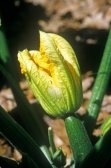More than the economy is falling on hard times these days. A potentially huge problem is looming for gardeners and food growers everywhere.
 I just had a friend share with me that, in her area, zucchinis aren’t setting full fruits. So I checked my plants and , lo and behold, found some developmentally challenged zukes in my own garden. Confirmed in newspapers and online sources, many zucchini and squash plants are setting miniature or quickly rotting fruits.
I just had a friend share with me that, in her area, zucchinis aren’t setting full fruits. So I checked my plants and , lo and behold, found some developmentally challenged zukes in my own garden. Confirmed in newspapers and online sources, many zucchini and squash plants are setting miniature or quickly rotting fruits.
The reason? The decline of the honeybees is limiting the number of pollinated zucchini. This is because all squash plants (having a male and female flower) require outside aid for pollination to occur.
There is a relatively easy solution for the backyard gardener and small grower — attracting more bees and/or hand pollinating. For the small gardener, hand-pollinating is the quickest way to ensure this year’s crop.
So how does one hand-pollinate zucchini (or any squash)? Read on.
Zucchini Fail to Set Fruit Properly When Not Pollinated
by Sally Morton
Pollinating zucchini or squash by hand may be required in the absence of bees in your garden. They won’t produce proper fruit without pollination.
A common reason for rotting and shriveling zucchini is lack of pollination by bees. Pollination is absolutely required for fruit set. Without pollination, the fruit that grows will yellow, shrivel, rot and die. Three solutions: Get some bees. Attract some bees (see “Butterfly and Bee Garden“) or hand pollinate.
The zucchini has a male flower and a female flower, which must be pollinated in order for you to get proper fruit. To hand pollinate, break off a male flower, remove its petals to reveal the yellow pollen on its pistol, then roll the pollen onto the center stigma of the female flower.
You tell flowers apart because female flowers are larger and have a baby fruit behind their petals. The male flowers grow on a long stem and are smaller.
Some people use a cotton swab or artist’s brushes to hand pollinate– a good idea.
As for me? You’ll find me out in my garden busy as a bee.


Good tip, it’s alarming to see the bee decline. It has been interesting this year to really take notice of all the other pollinators. The hummingbirds have been haunting the greenhouse, and I saw one zip out of the summer squash the other day. I think they are attracted to the smell of the Swiss Chard going to seed.
Heavenly!
Ohio has been feeling the bee colony losses. Locally though we seem to be fairing better than most. I know that several long-time residents have bee boxes in their backyards and the county apiary society maintains research hives in one of the reserves.
I just planted my first butterfly garden this spring, annuals this year as the bed needs a few years of work before perennials would thrive. I have seen bees and Black Swallowtails plus a variety of moths there. The bee in today’s post is not from my garden it was at a park.
Same. It’s quite discouraging this year. Between lack of bees and over-abundance of slugs this year, my garden is feeling very sad